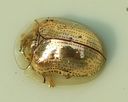Golden Tortoise Beetle
Charidotella sexpunctata
Classification
- Phylum: Arthropoda
- Subphylum: Hexapoda
- Class: Insecta
- Order: Coleoptera
- Suborder: Polyphaga
- Superfamily: Chrysomeloidea
- Family: Chrysomelidae
- Subfamily: Cassidinae
- Tribe: Cassidini
- Genus: Charidotella
- Species: sexpunctata
Pronunciation
How to pronounce Charidotella sexpunctata: /kæɹɪdoʊˈtɛlə sɛksˌpʌŋkˈteɪtə/
These audio files are automatically generated. While they are not always 100% accurate, they are a good starting point.
Images






Summary
Charidotella sexpunctata, known as the golden tortoise beetle, is a species of leaf beetle notable for its color-changing capabilities and relationship with host plants in the Convolvulaceae family.
Physical Characteristics
Overall golden-orange or golden-yellow with or without black elytral spots; legs mostly yellow; body oval or almost circular-shaped; elytral margins transparent; elytra and pronotum highly reflective in living specimens; adults measure 5–7 mm.
Identification Tips
Variable in color from reddish-brown with black spots to brilliant, mirror-like gold. Color changes occur during development, mating, and when disturbed.
Habitat
Found across a range of environments where host plants of the family Convolvulaceae are present.
Distribution
Transcontinental distribution from British Columbia to Nova Scotia and down to Florida, extending to South America. Specific subspecies distribution includes C. s. sexpunctata from Texas to South America and C. s. bicolor from eastern North America to Texas and western North America.
Diet
Feeds on foliage of Convolvulaceae family plants, including bindweeds, morning glory, and sweet potato.
Life Cycle
Female lays eggs in clusters on stems and undersides of leaves; larvae emerge in 5 to 10 days, evolving through a larval stage that lasts 2 to 3 weeks before pupation, which lasts 1 to 2 weeks before emerging as adults.
Reproduction
Mating occurs with significant behavioral activity, including color change during the process. Females lay eggs on host plants.
Predators
Parasitoids include the eulophid wasp Tetrastichus cassidus and the tachinid fly Eucelatoriopsis dimmocki. Predators of the larvae include ladybird beetles, damsel bugs, shield bugs, and assassin bugs.
Ecosystem Role
Involves in the dietary composition of higher trophic levels as prey and also contributes to plant predation on host plants.
Similar Taxa
Tags
- Golden Tortoise Beetle
- Charidotella sexpunctata
- Beetles
- Insects
- Chrysomelidae